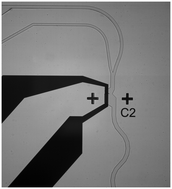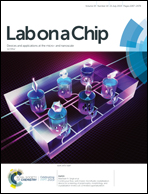Cell sorting actuated by a microfluidic inertial vortex†
Abstract
The sorting of specific cell populations is an established tool in biological research, with new applications demanding greater cell throughput, sterility and elimination of cross-contamination. Here we report ‘vortex-actuated cell sorting’ (VACS), a new technique that deflects cells individually, via the generation of a transient microfluidic vortex by a thermal vapour bubble: a novel mechanism, which is able to sort cells based on fluorescently-labelled molecular markers. Using in silico simulation and experiments on beads, an immortal cell line and human peripheral blood mononuclear cells (PBMCs), we demonstrate high-purity and high-recovery sorting with input rates up to 104 cells per s and switching speeds comparable to existing techniques (>40 kHz). A tiny footprint (1 × 0.25 mm) affords miniaturization and the potential to achieve multiplexing: a crucial step in increasing processing rate. Simple construction using biocompatible materials potentially minimizes cost of fabrication and permits single-use sterile cartridges. We believe VACS potentially enables parallel sorting at throughputs relevant to cell therapy, liquid biopsy and phenotypic screening.



 Please wait while we load your content...
Please wait while we load your content...